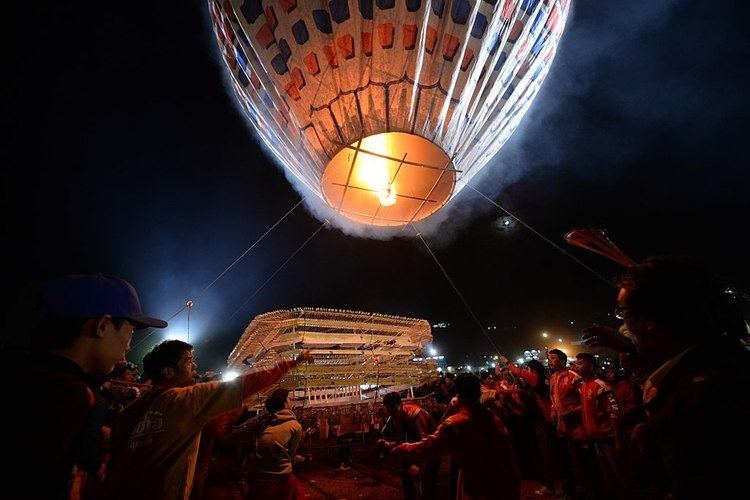Also called Festival of Lights Type Buddhist 2017 date November 3 | Observed by Burmese 2016 date November 14 | |
Date Full moon day of Tazaungmon Similar Thadingyut Festival, Christmas, New Year's Day | ||

The Tazaungdaing Festival (Burmese: တန်ဆောင်တိုင်ပွဲတော်, also known as the Festival of Lights and spelt Tazaungdine Festival), held on the full moon day of Tazaungmon, the eighth month of the Burmese calendar, is celebrated as a national holiday in Burma (Myanmar) and marks the end of the rainy season. It also marks the end of the Kathina (Kahtein in Burmese) season, during which monks are offered new robes and alms.
The festival's origins predate the introduction of Buddhism to Burma, and are believed to stem from the Kattika festival, which honors the guardian planets in Hindu astrology.
Celebrations
Robe-weaving competitions to weave special yellow monk robes called matho thingan (မသိုးသင်္ကန်း) are also held throughout the country, most notably in Yangon's Shwedagon Pagoda. During these competitions, held for two consecutive nights (the night preceding and the night of the full moon), contestants work nonstop from night until dawn to weave these garments. The tradition commemorates a widely known story of the Buddha's life. Seeing that the Buddha would soon renunciate, the Buddha's mother, Maya, who had been reborn in the Tavatimsa heaven, spent the entire night weaving yellow monk robes for him. Her sister Gotami (Buddha's aunt) continued this tradition and offered new robes annually.
In Shan State, particularly in Taunggyi, hot air balloons lit with candles, are released to celebrate the full moon day, similar to Yi Peng celebrations in Northern Thailand. The balloons are released as an offering to the Sulamani cetiya in Tavitisma, a heaven in Buddhist cosmology and home of the devas, or as a way to drive away evil spirits, although the origins of the tradition date back to 1894, when the British first held hot air balloon competitions in Taunggyi, soon after the annexation of Upper Burma. In recent years, these traditions have also been transported to other parts of the country, including Naypyidaw, which holds an annual government-sponsored celebration, and Pyin Oo Lwin (Maymyo).
Almsgiving and charity, both religious and secular, including satuditha feasts (စတုဒိသာ), are also commonly undertaken during this festival, as a means of merit-making. Others return home to pay homage to elders (gadaw) and visit pagodas. Many concerts and other secular festivities, such as live performances of traditional dramas like the Yama Zatdaw, are also held between Thadingyut (the end of the Buddhist lent) and Tazaungdaing.
In pre-colonial times, the Burmese court worshiped 15 Hindu deities on the full moon day. On the eighth waning day of that month, after a procession to the king, 8 pyatthat structures made of bamboo were burned.
On this night, young men celebrate a custom called "kyimano pwe" (ကျီးမနိုးပွဲ, lit. "crow doesn't wake"), by practicing mischief on their neighbors, by stealing or playing tricks on them.
